
For a description of generic settings common to all tools in the Toolbox, see Working in Tool Settings Dialog Boxes.
For general information, see Walls.
Wall Geometry and Positioning Panel

By default:
•Wall top is linked to one story up
•Home Story is the current story.
For more information, see Home Story.
The story to which the Wall bottom is linked is called the Home Story, but you can offset the bottom in either direction.
Use the controls in this panel to change any of these values, and to define the geometry and complexity of the Wall element.
Wall top: Use this control to either top link the Wall relative to its Home Story (Home+1, Home+2, etc.), or to make it a fixed-height wall (choose “Not linked”).
If you later modify the positions and heights of stories in your projects, the heights of any linked Walls will follow automatically.
•Optionally, define an offset for the Wall top from its top linked story (the Wall height changes accordingly). This offset value can be positive, negative or zero.
The offset field is not available if the Wall has no top link.

Wall height: Enter a value for the total height of the Wall. (For a top linked Wall, this field is not editable.)
•The Wall height value is affected by the top and bottom offsets, if any. If you change the top offset of a top linked Wall, or its bottom offset from the Home Story, this change will be reflected in the height value.
Home Story
Choose one of the following Home Story settings:
•The current story: The Wall’s Home Story will be the current story, on which it is placed.
•Choose a story to which to link the bottom of the Wall. Click Select Story to bring up the full list of stories in the project, if they are not all shown in the list.
•Optionally, define an offset for the Wall bottom from its Home Story. (For a top linked Wall, the Wall height changes accordingly.)
The bottom of the Wall (where the Wall reference line is) is physically linked to its Home Story. If you later modify the Home Story’s position (e.g. redefine the floor level), the Wall will change its position (while respecting the defined offset, if any).
If you delete the Wall’s Home Story, the Wall will be deleted, along with all other elements located on the story.
If you change a Wall’s elevation so that its reference line is moved to a different story, you have the option to make the Home Story change to match the element’s new location.
See Change Home Story by Elevation.
For more information, see Home Story.
Bottom Elevation [to Reference level]: Calculates the current elevation of the Wall’s reference line, as measured from the Reference level (by default, this Reference level is Project Zero). Click the pop-up arrow to change the Reference level, if needed.
Note: Reference levels are defined at Options > Project Preferences > Reference Levels.
For general information on levels, see Reference Levels.
Note: The Bottom Elevation shows the current elevation of the Wall bottom. Thus, this value serves as a calculation tool only, not a link. If you change the position of a Reference level, the Wall will not change its position.
Click one of these icons to define the Wall as Basic, Composite, or Complex Profile, and then choose an attribute that reflects its structural properties:
•For a Basic Wall: use the pop-up to choose its Building Material.

•For a Composite Wall: use the pop-up to choose its Composite structure.
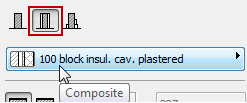
Note: This pop-up shows only those Composite Structures whose “Use With” control includes Walls. Composites are defined at Options > Element Attributes > Composites.
•For a Complex Profile Wall: use the pop-up to choose its Profile.
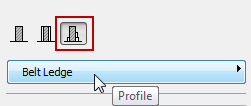
Note: This pop-up shows only those Profiles whose “Use With” control includes Walls. Profiles are defined at Options > Element Attributes > Profile Manager.
Geometry Method
Click one of these three icons to draw the Wall as either straight, trapezoidal or polygonal.
•These options are not available for Complex Profiles.
•The polygonal option is not available for composite Walls.
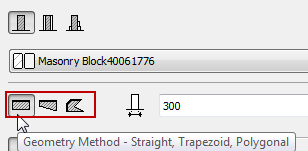
Enter a value for the wall thickness.
•If you are creating a trapezoidal Wall, two thickness fields are active: enter a thickness value for each end of the Wall.

•The thickness of a composite Wall is the total value of the individual skins as set in Options > Element Attributes > Composites. If you are creating a composite Wall, the thickness field is consequently not editable here.
•Thickness does not apply to polygonal Walls; the field cannot be edited.
•The thickness of a slanted Wall is its thickness perpendicular to its slant vector:

•The thickness of a double-slanted Wall equals the width of the Wall base.

The Wall Complexity icons give you a choice of Wall geometry: Straight, Slanted, or Double-Slanted. (Wall Complexity controls are not applicable and not available for Trapezoid Walls and Polygonal Walls.)
•For a slanted or double-slanted Wall, enter the value for the slant(s) in degrees.
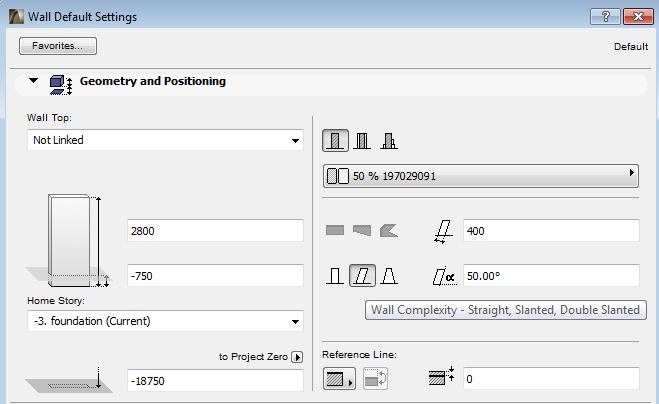
For more information, see Create a Slanted or Double-Slanted Wall.
This checkbox is only visible when the chosen geometry method is Polygonal Wall. It controls the display of wall contours when connecting such a wall to other, plain walls.
For more information, see Create a Polygon Wall (PolyWall).
Click an option to define the Wall’s reference line.
Note: Reference line controls in Wall Settings do not apply to Polygon walls. (Polygon wall reference lines can be moved graphically via the pet palette.)
A basic Wall has three possible reference lines: Outside Face, Center, or Inside Face.
By default, the reference line runs along the outside face.
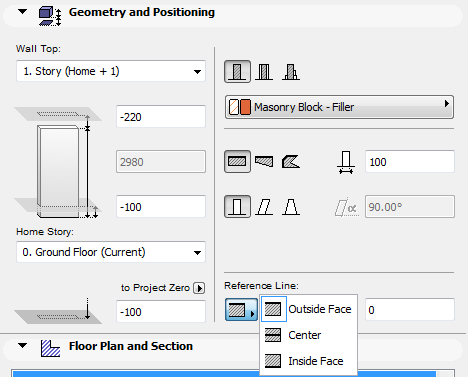
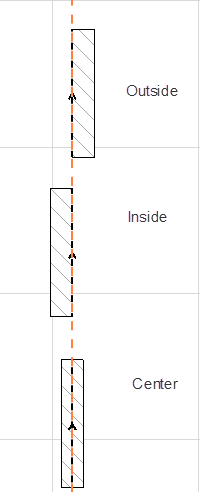
A composite Wall has six possible reference lines: Outside/Center/Inside of the Wall, plus Outside/Center/Inside of the Wall core.
Note: If the chosen composite structure has no core, then the core-related Reference Line choices are greyed out.
By default, the reference line runs along the outside face.
For a composite, the “outside” face is the top skin of the composite, in Composite Settings.
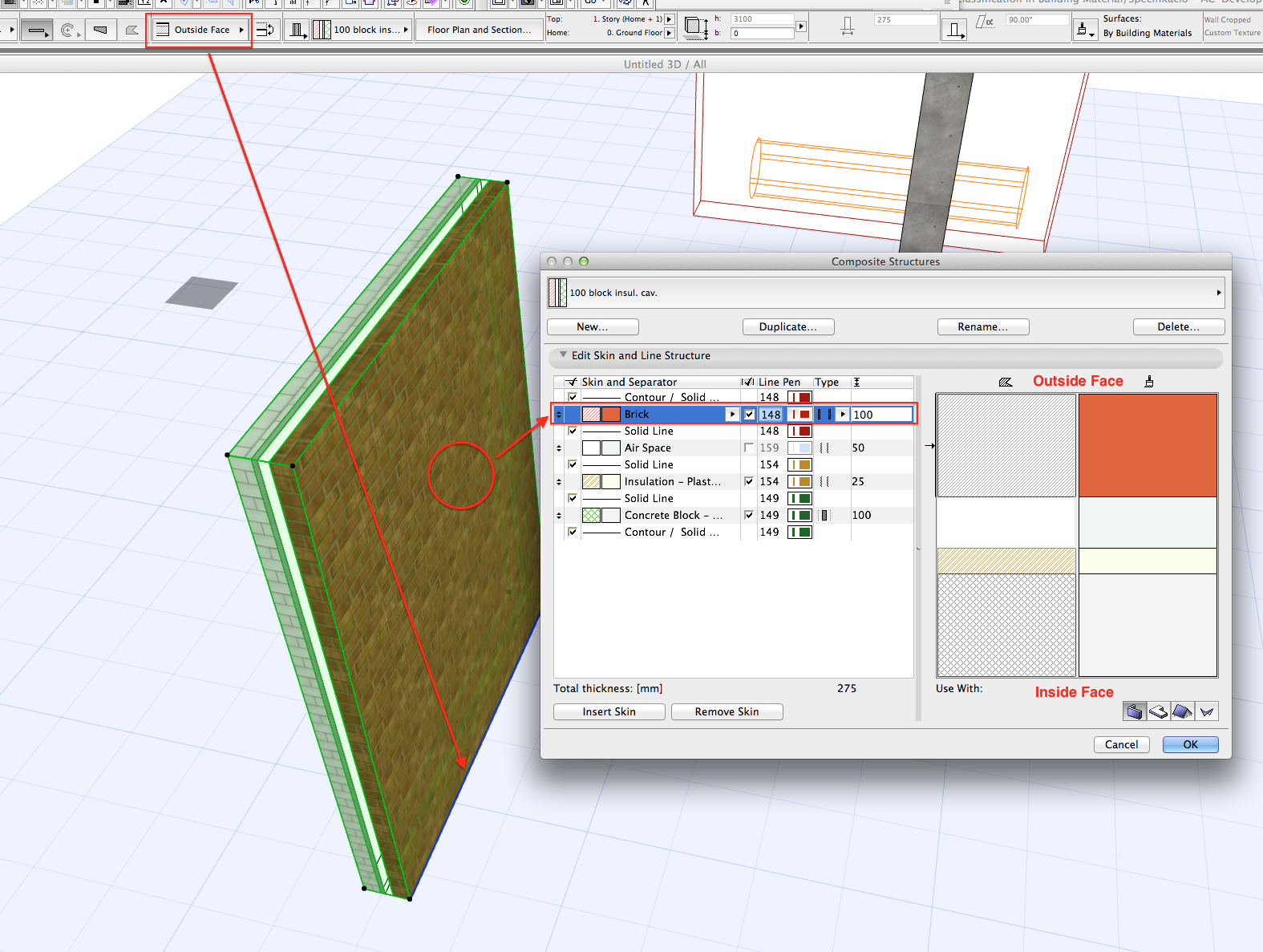

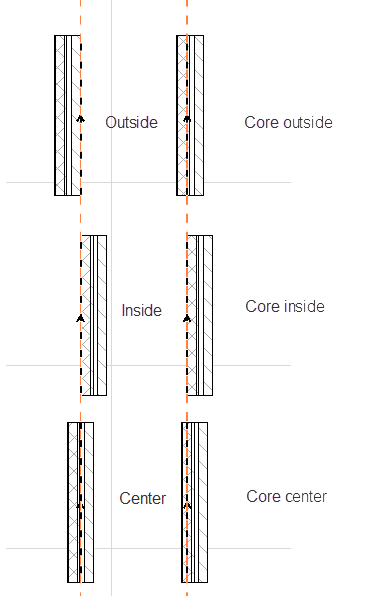
A Trapezoid wall has two possible reference line locations: Outside Face or (if it is a composite Wall that has a core) Core Outside.
Reference Line Offset: If using an “outside” or “inside” reference line, enter a positive offset to move the reference line toward the center (or center of core) of the Wall. A negative offset will move the reference line away from the center (or core center). (No offset is available if the reference line is in the center or core center.)
For more information, see Wall Reference Line.
Wall Floor Plan and Section Panel
Floor Plan Display
Show on Stories: Choose an option to define which stories will display the wall.
•All Relevant Stories: A multi-story wall will be displayed and editable on all stories which it intersects. Multi-story walls will be correctly joined with other elements on all stories where the multi-story wall is present.
•Home Story Only: This wall will be displayed only on its Home Story.
For more information, see Home Story.
Floor Plan Display: Choose an option to define the Wall’s display on the Floor Plan.
•Projected: shows cut part of Wall’s 3D model, plus its uncut (downward) part.
•Projected with Overhead: shows cut part of Wall’s 3D model (i.e. as cut at the level of the Floor Plan Cut Plane), plus the Wall’s overhead part (i.e. the part of the Wall that is above the Floor Plan Cut Plane.
•Cut Only: displays only the cut part, as cut with the Floor Plan Cut Plane.
Three additional abstract display options are available:
•Symbolic Cut: Available only for simple straight Walls. This option is available only if the Show on Stories control is set to “Current/Home Story only”.
The whole floor plan projection of a simple straight Wall will be displayed as cut, using its cut line and Building Material attributes, regardless of the Wall’s vertical position. The Floor Plan Cut plane settings do not affect the display of such a Wall.
•Outlines Only: the entire Wall’s outline is shown using its uncut attributes.
•Overhead All: the entire Wall’s outline is shown using its overhead attributes.
Show Projection: This pop-up contains three options. (These are available only when the Floor Plan Display option is set to one of the “Projected” options.)
•To Floor Plan Range: Choose to show the Wall on a range of stories (the current story, plus a given number of stories above and below it.)
Note: If you choose this option, then you can set the desired range (i.e. the number of stories on which to show this Wall in either direction) in Floor Plan Cut Plane Settings.
•To Absolute Display Limit: Set a fixed lower limit (by default, this is Project Zero), then show all parts of the Wall above this limit.
Note: If you choose this option, go to Floor Plan Cut Plane Settings to set the Absolute Display Limit.
•Entire Element: The Wall will be displayed on all relevant stories.
For details, see Floor Plan Cut Plane Settings Dialog Box.
Cut Surfaces: In this section, set the attributes displayed for cut surfaces both in Section and on the Floor Plan.
•For a basic Wall:
•Define the cut line type and pen
•For a basic, composite or complex profile Wall:
•If needed, override the fill foreground/background pens of this element (defined by default in the Building Material). To do this, choose Foreground, Background or Both from the Override Cut Fill Pens pop-up to access the respective controls.

Outlines: Use these settings to define line types and pen colors to element outlines that fall above (Overhead) and/or below (Uncut) the Floor Plan Cut Plane.
•Overhead Lines will be displayed if the Floor Plan Display pop-up is set to “Projected with Overhead” or “Overhead All”.
•Uncut Lines will be displayed if the Floor Plan Display pop-up is set to “Projected” or “Outlines Only.”
Wall End Lines: This pop-up gives you four ways to display a freestanding wall on the Floor Plan. The options let you show or hide one or both end lines of the wall. (The end line is the contour line perpendicular to the longitudinal axis of the wall.)
This panel affects the 3D display of the wall.
Override Surfaces: Click the toggle button of any or all three pop-ups if you wish to override the surface assigned to this element (in its Building Material). You can override the surfaces of the Wall’s faces (outside and inside), and/or all Wall edges.
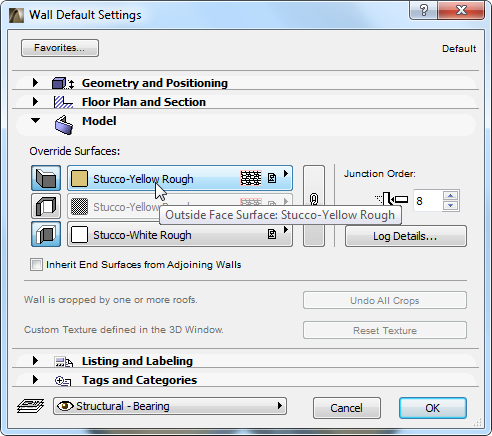
For a composite Wall, the “outside” surface is the first listed skin of the composite, in Composite Settings.
Note: For a complex Wall, only the edge surface control is available.
For information on surfaces of Complex Profile elements, see Profile Manager Dialog Box.
For information on assigning surfaces to a Polygon wall, see Create a Polygon Wall (PolyWall).
For a profile Wall, there are two surface override possibilities: Extrusion edge and Ends surface.
Note: You can also apply a Custom surface to any edge(s) of the profile element. See Apply Custom Surface or Line to Profile Edge.
Click the chain icon to assign the last surface chosen to all faces and edges. Deselecting the chain icon will restore the surfaces that you originally set for each wall face/edge.
Note: The chain icon is available when all the surfaces use overrides.
For more information, see Surfaces.
End Surfaces: Override using Adjoining Walls: Check this box if you want the selected Wall’s end surface to take on the surface of the adjoining Wall.
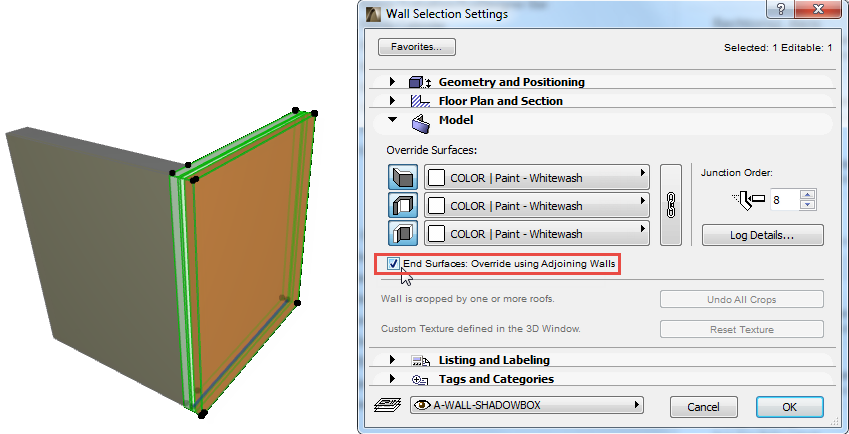
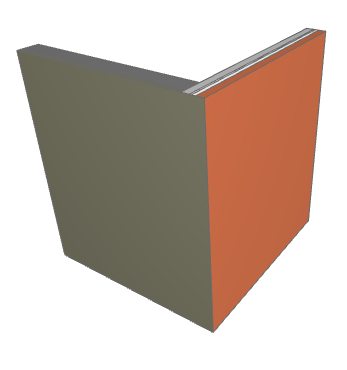
Wall is cropped by one or more roofs: If this message is activated, it means that the currently selected wall (already placed in the project) is trimmed by a roof using the Crop to Single-Plane Roof command.
•In this case, the Undo All Crops button is also activated. Click to restore the original height of the selected wall.
For more information, see Crop Elements to Single-plane Roof.
Custom Texture defined in the 3D window: If this message is activated, it indicates that the currently selected wall (already placed in the project) has been assigned a custom 3D texture.
•In this case, the Reset Texture button is also activated. Click to restore the origin of the Texture of the selected wall.
For more information, see Align 3D Texture.
Junction Order is relevant when
•two Walls meet whose Building Materials have the same priority
•3 or more Walls meet in a junction
A higher Junction Order number takes priority over the lower.
When 3 or more Walls meet in a junction, the relative Junction Order of each Wall determines which two Walls are joined first.
The Log Details button opens a dialog box for defining the display of walls constructed from logs:
•Use Log Wall: Check this box to use a Log Wall. If it is unchecked, no logs will be displayed.
Note: ArchiCAD calculates the number of logs from wall and log heights.
•Start with half log: If this checkbox is active, the wall will start with a half-height log at the bottom.
•Log Shape:
•Square logs: Use square logs on both sides of the wall.
•Rounded on Outside Face: Use logs that are cambered on the outside face. The inside wall face will remain flat.
•Rounded on Inside Face: Use logs that are cambered on the inside. The outside wall face will remain flat.
•Rounded on Both Sides.
•Log Radius: choose an option for measuring log radius: either from the log centerpoint, or from the middle point of the opposite log.
•Surface of Horizontal Edges:
•As in Wall Settings: Click this radio button to apply the Building Material’s surface to Log walls.
•Override with Outside Face Surface: Click this radio button to use the outside face surface on horizontal surfaces of Log walls.
•Override with Inside Face Surface: Click this radio button to use the inside face surface for horizontal surfaces of Log walls.
•Align Texture to Wall Edges: By enabling this checkbox, texture mapping will be aligned to the wall height to avoid a fragmented texture on the wall edges. (This control applies to textures of any wall, not just log walls.
Wall Listing and Labeling Panel
See Listing and Labeling Panels.
For Walls and Columns only, some additional controls are also available:
Relation to Zones: Click this field to define the relationship of the Wall to Zones. This field defines whether the new Wall is a Zone delimiter, an element to subtract from the Zone’s area or to be ignored when calculating Zones.
•Zone Boundary: This option means that a wall located inside a zone will not be included in the zone area. In every case, including slanted or complex walls, the zone boundary is drawn at the base of the wall. Multi-story elements in automatic display mode can serve as zone boundaries on any story on which they exist, not just their Home Story.
•Reduce Zone Area Only means that the 2D zone will encompass the wall, but the wall area will not be included in the zone area. (Zone Volume, however, will include the wall.)
•Subtract from Zones means that when calculating the zone’s 3D volume, the volume will not include the volume of any wall located inside the zone.
•No Effect On Zones means that the wall has no effect on the zone; the zone area and volume will include the area covered by the wall.
Related Topics:
Calculating Zone Area and Zone Volume
Wall Tags and Categories Panel